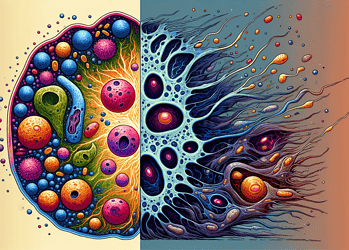When we breathe, gases are exchanged between blood and tissues. This is known as internal respiration. However, individual cells have their own respiration, known as cellular respiration — the oxidative metabolism of glucose inside the cell’s mitochondria (in the case of eukaryotic cells).
Cellular respiration is critical to any living organism since it is this process that essentially turns food into energy that the body needs to survive.
Thanks to cellular respiration, cells convert the energy stored in glucose and other nutrients into a more usable form, known as adenosine triphosphate (ATP).
Every time you twitch a muscle, breathe, replicate your DNA, or think, you’re using ATP to do all of this work.
However, the process of converting sugar into ATP isn’t as straightforward as it sounds and involves quite a number of steps and complex organic chemistry.
If you ever wondered how a hamburger is turned into energy to power the 75 trillion cells inside the human body, here’s how it all works.
The stages of cellular respiration

During cellular respiration, several oxidation-reduction (redox) reactions transfer electrons from organic molecules to other molecules, eventually converting glucose (life’s basic nutrient) into ATP, the energy currency employed by biological processes. Oxidation refers to electron loss and reduction to electron gain.
Although cellular respiration involves many chemical reactions, the process can be summed up with the following simplified reaction:
C6H12O6 + 6O2 → 6CO2 + 6H2O + Chemical Energy (ATP)
The above chemical reaction tells us that glucose (sugar) is burned (oxidized) by reacting with a lot of oxygen to form water and carbon dioxide, as byproducts, along with ATP. Both sugar and oxygen are delivered to cells through the bloodstream.
The process can be broken down into four steps of cellular respiration.
- Glycolysis. This is the first phase of the carbohydrate catabolism, meaning the breaking down of a larger molecule into smaller ones. During glycolysis, sugar is broken down in a cascade of chemical reactions into two molecules pyruvate and two molecules of ATP. Much more ATP, however, is produced later in the cellular respiration cycle. The pyruvate is shuttled into the mitochondria — tubular-shaped organelles that are found in the cytoplasm of every eukaryotic cell — where it is converted into Acetyl coenzyme A (CoA) for further breakdown.
- The Tricarboxylic acid cycle. Also known as the TCA cycle, the Krebs cycle, and the citric acid cycle, this stage takes place in the matrix of the mitochondria where all the hydrogen molecules are stripped off the Acetyl CoA to extract electrons required for making ATP. The reaction extracts electrons, releasing CO2 and H2O as waste. Only four ATP molecules are produced, along with a lot of NADH (a crucial coenzyme in making ATP). NADH, along with another molecule called flavin adenine dinucleotide (FADH2) will ultimately transport the electrons to the inner membrane of the mitochondria.
- The electron transport chain. The final process of cellular respiration takes place in the cristae of the mitochondria. Electrons carried by NADH and FADH2 are passed along a series of enzymes (the chain), releasing energy that expels protons. The resulting proton gradient enables the synthesis of roughly 32 ATP molecules for every molecule of glucose. Now we’re talking!
Did you count all the ATP molecules? That’s around 38 ATPs for every glucose.
Cellular respiration doesn’t necessarily require sugar. When the body runs out of glucose, it can burn fats and proteins to make ATP instead. This is what actually happens when people are on low-carb diets such as Atkins or Keto.
Anaerobic respiration
What happens if there is no oxygen? Well, humans die, but there are certain bacteria and fungi that can generate ATP in environments with very low levels of oxygen or even none to speak of.
This happens through anaerobic respiration, a process that only goes as far as glycolysis. As such, anaerobic respiration, also known as fermentation, is highly inefficient since it generates only two molecules of ATP.
Cells in the human body can also undergo anaerobic respiration when there is suboptimal O2 intake, such as when you’re working out heavily. This results in the production of lactic acid, which causes muscles to become more acidic. This is why you feel sore and in pain after intense physical exercise.
Bottom line: When the term ‘respiration’ comes to mind, we tend to associate it with breathing and the lungs — but this is only where the process starts. The lungs pull in the oxygen that the mitochondria need to burn sugar and then release the CO2 generated as a byproduct of breaking down the sugar. Though you breathe in through your lungs, the harder work, what keeps your body going, is happening at the cellular level.






